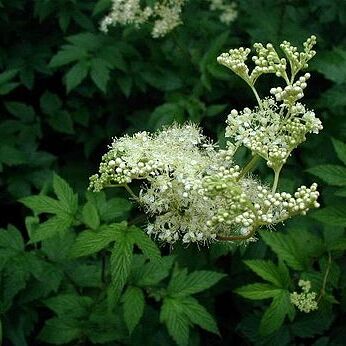Herbs perennial, rhizomatous. Rhizome short, oblique, here and there thickened into tubers, clothed with fibers. Stipules large or small, subcordate to ovate-lanceolate; leaf blade pinnate; leaflets pinnately or palmately lobed. Inflorescence corymbose-cymose or paniculate-cymose; central branch shortened and flowering first. Flowers bisexual, rarely unisexual (when plants dioecious). Sepals 5, reflexed after flowering. Petals 5, imbricate, white, pink, or red, base clawed. Stamens 20–40. Carpels 5–15, inserted on plane or slightly elevated receptacle, free; ovules 1 or 2; style terminal; stigma capitate. Fruit an achene, free, compressed, crowned by base of style. Seed pendulous, terete, with very little endosperm. x = 7, 8.
Perennial herbs, not armed, shortly rhizomatous with rhizomes sometimes thickened into tubers; stems herbaceous or slightly woody, usually erect. Lvs mostly basal, some cauline, imparipinnate or palmately lobed, usually with small leaflets between larger ones; stipules large, semicordate, persistent. Infl. a many-flowered, ebracteate, cymose panicle. Fls 5-6-merous, usually ☿, small, pale cream to reddish or sometimes purplish beneath. Hypanthium flat to slightly concave. Epicalyx 0. Calyx of ± triangular sepals, persistent and sometimes reflexed after flowering. Petals ± imbricate, > sepals. Stamens 20-40. Ovary superior; carpels and styles 5-15, in one whorl; ovules 2 per carpel. Fr. a compact head of free achenes.
Hypanthium cupulate; fls 5–7-merous; sep ovate or oblong, reflexed; pet spreading; stamens 20–40, inserted at various levels in 10 longitudinal rows opposite the perianth-members; pistils 5–15, in a circle, the ovaries erect; styles clavate, outcurved; stigmas large, capitate; frs 1-seeded, resembling a follicle in appearance but indehiscent; perennial, rhizomatous herbs with stipulate, pinnately compound lvs (some tiny lfls commonly intermingled with the principal ones) and large panicles of white to pink fls, the lateral branches of the panicle surpassing the axis. 10, Temp. Eurasia and N. Amer.

